Spaghetti Arrabiata (Spaghetti all’Arrabbiata)
Spaghetti Arrabiata is a simple yet flavorful dish that highlights the essence of Italian cooking.
Using San Marzano tomatoes as its foundation, the sauce has a pleasant sweetness that balances out the spicy kick from the red pepper flakes. The added garlic and onion provide a savory depth, and the hint of fennel seeds gives it a unique touch. A splash of olive oil lends a smooth texture, and the fresh basil brings a light, aromatic freshness. Topped with a bit of grated Parmesan, this dish is a true representation of classic, home-cooked Italian fare.
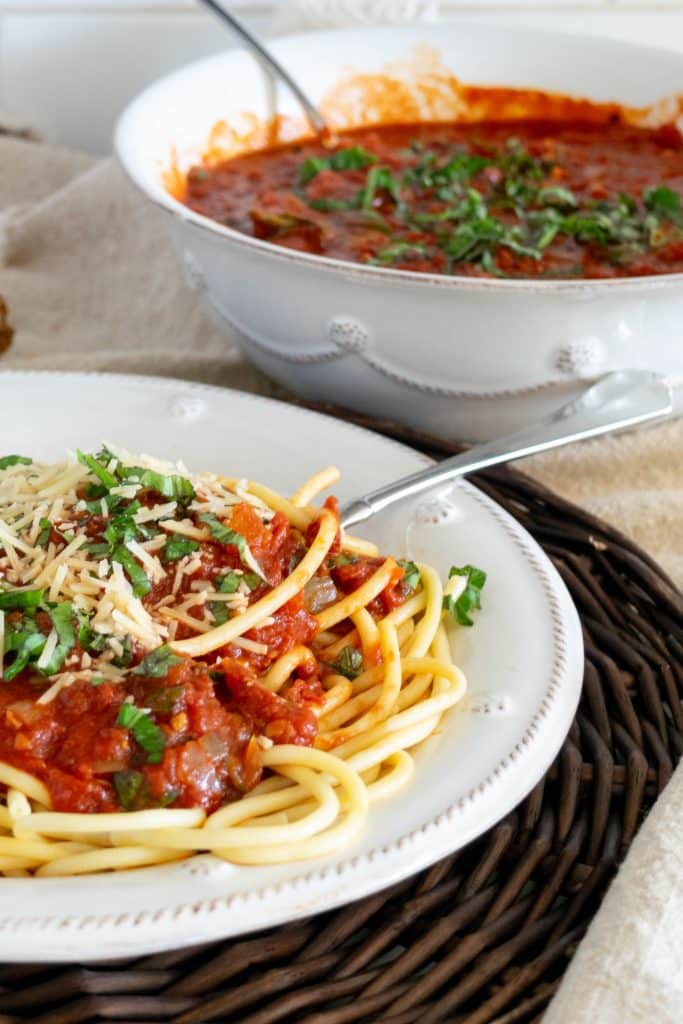
Table of Contents
origins of Spaghetti Arrabbiata
Spaghetti Arrabbiata hails from the Lazio region of Italy, with its roots in the capital city, Rome. The name “Arrabbiata” translates to “angry” in Italian, which aptly describes the spicy, fiery nature of the sauce due to the generous use of red chili pepper flakes.
The absolutely correct spelling is with two r’s and two b’s, as in Arrabbiata. I’m typically a stickler for correct spelling, but it seems most people search for it as ‘Arrabiata’, with just one b. So, I decided to use it both ways, wanting to make sure that anyone getting close to the spelling can find this recipe.
ingredients in Spaghetti Arrabiata
Some of these links may be Amazon affiliate links and I may earn a small commission from the sale of these products to help defray the costs of operating this site, but the price you are charged is not affected. You can see my full disclosure policy here.
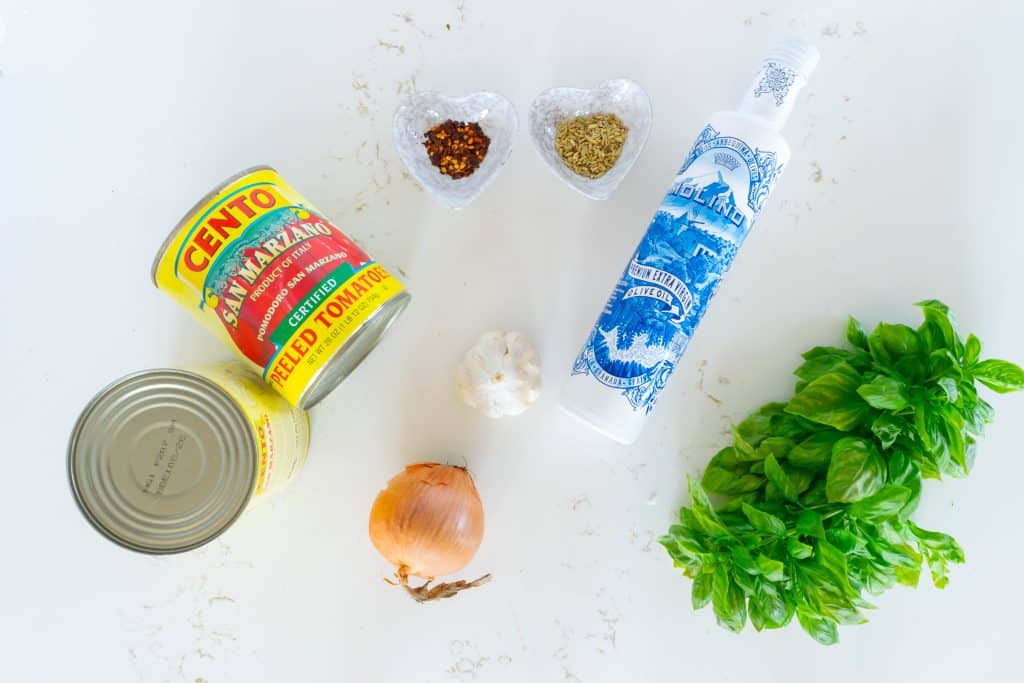
for the sauce
- Onion: Using onion in pasta sauces provides a sweet undertone that balances out the spiciness and acidity of other ingredients. Dice them finely to ensure they melt into the sauce, giving a smoother consistency.
- Garlic: A foundational ingredient in many Italian dishes. Garlic provides a fragrant aroma and robust flavor. Using 8-10 cloves gives the dish a prominent garlic presence.
- Red Pepper Flakes: This is what gives the arrabiata sauce its signature heat. “Arrabbiata” means “angry” in Italian, and the name signifies the spiciness of this sauce. Adjust the quantity based on your heat preference.
- Crushed Fennel Seeds: An aromatic herb that adds a slight anise or licorice flavor. It complements the tomato and garlic very well. If you’re not a fan of fennel, you can reduce the amount or skip it, but it does provide a distinct flavor note in the sauce. I use this cast iron spice grinder to crush the fennel for this recipe.
- Good Olive Oil: Quality matters. A good, extra virgin olive oil will impart a rich, fruity undertone to the sauce.
- San Marzano Tomatoes: These are the gold standard for Italian sauces. San Marzano tomatoes are sweet, pulpy, and less acidic, making them perfect for pasta sauces.
- Salt and Pepper: Essential for seasoning. It’s best to add gradually, tasting as you go to achieve the desired flavor balance.
- Fresh Basil: Basil imparts a sweet, aromatic flavor and is almost synonymous with Italian cooking. Julienned basil will be distributed more uniformly throughout the sauce. Always add fresh herbs towards the end of cooking to preserve their flavor and color.
- Red Wine ( Optional): The wine adds depth and complexity to the sauce. Chianti is a dry, robust wine that pairs wonderfully with the acidity of tomatoes. It’s optional, but if used, it’ll give the sauce a richer flavor.
When cooking, remember that the key to a good sauce is to let it simmer and meld, allowing the flavors to integrate beautifully. Adjust the seasoning as needed, and always taste as you go to ensure the balance of flavors is just right. Enjoy your Spaghetti Arrabiata!
for serving
- Grated Parmesan Cheese: Parmesan adds a salty, nutty flavor. Serving the dish with Parmesan allows each person to adjust the cheesiness to their preference.
- More Fresh Basil
- Spaghetti or Penne: The slender, long shape of spaghetti pairs well with the spicy tomato-based sauce, allowing the sauce to coat each strand evenly. However, the sauce’s versatility means it can also be paired with other types of pasta. For instance, penne is another popular choice for Arrabbiata, often called “Penne Arrabbiata.” The tubular shape of penne captures the sauce well, delivering a burst of flavor with each bite. While spaghetti and penne are the most typical, there’s no strict rule, and the sauce can complement a variety of pasta shapes based on personal preferences.
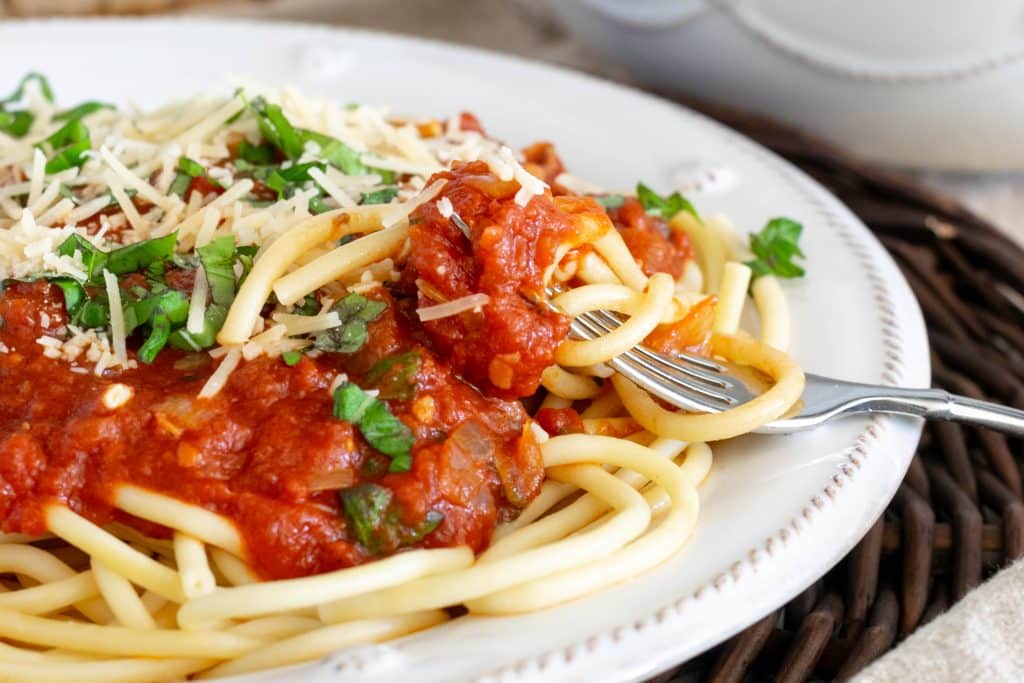
tips for the best Spaghetti Arrabiata
use San Marzano tomatoes
San Marzano tomatoes are considered ideal for Arrabbiata sauce for several reasons. They have a natural sweetness and low acidity, which counterbalances the heat of the red pepper, and their meaty texture and low water content result in a thicker, less watery sauce. When purchased canned, San Marzano tomatoes offer consistent quality, as they’re picked at their best and promptly preserved.
San Marzano tomatoes are regularly available in most grocery stores; I buy mine at Costco. If you can’t find San Marzano tomatoes, the closest would be canned, whole, and peeled Roma tomatoes.
finely dice and slowly cook the onions
By finely dicing and slowly cooking the onions, they almost melt into the sauce. Avoid browning the onions for a smooth taste.
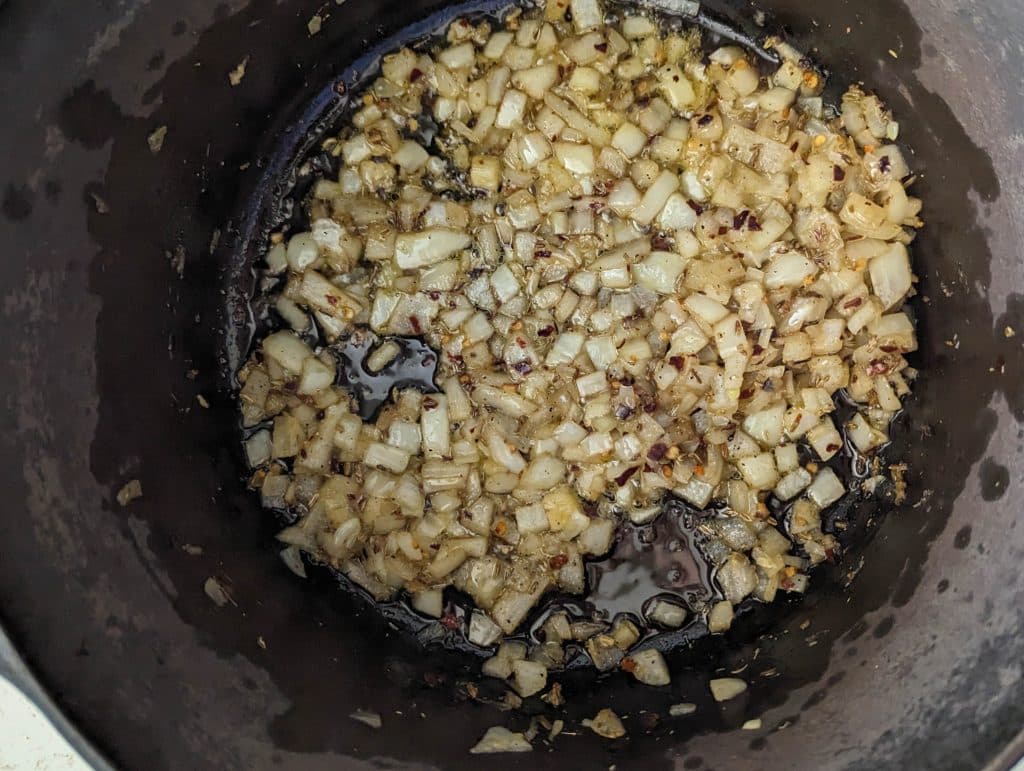
cook slowly over low heat
Allow the sauce to simmer slowly, letting the flavors meld together. A longer simmer can deepen the flavor, but be cautious not to overcook it, which can cause the tomatoes to become too acidic.
use a potato masher to crush the tomatoes in the pot
It’s easier to use a potato masher, but a large slotted spoon works well too. Just make sure you wear an apron, as exploding tomato juice is a thing!
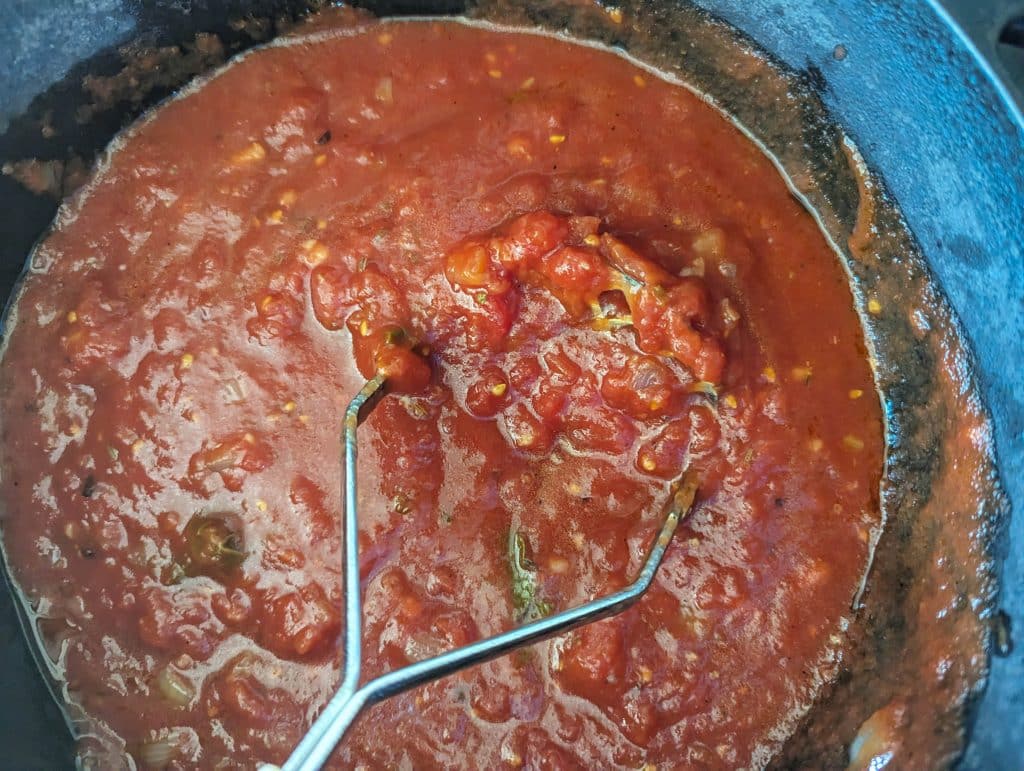
stir frequently
To prevent the sauce from sticking to the bottom of the pan and burning, make sure to stir occasionally, especially if simmering for an extended period
use freshly cooked pasta
Always toss the sauce with freshly cooked pasta. This ensures that the pasta absorbs the sauce’s flavor.
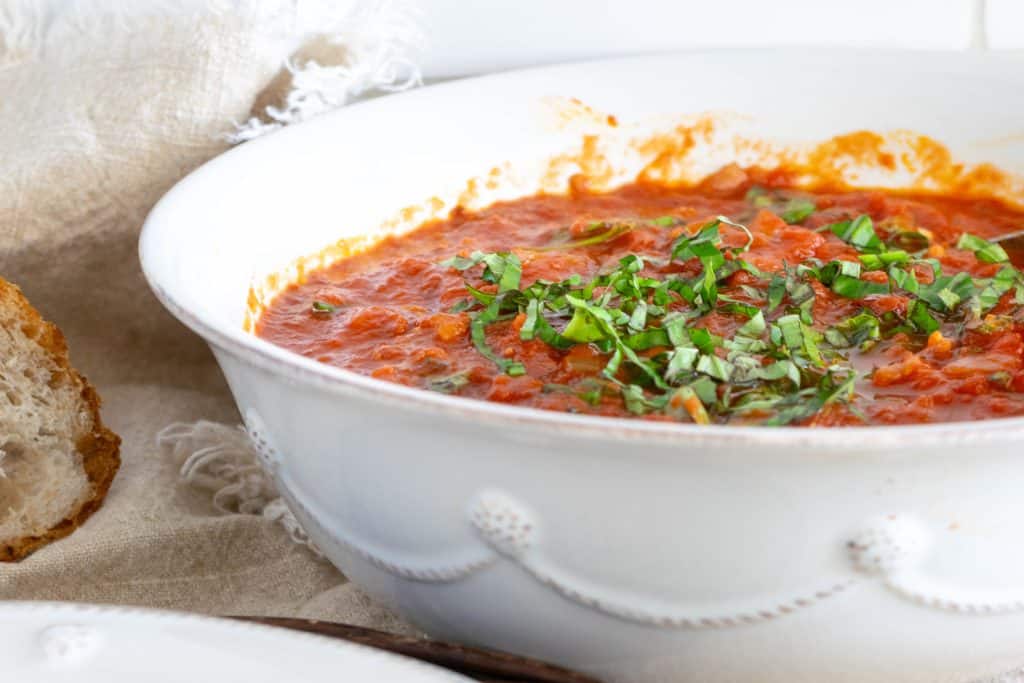
what wine pairs well with Arrabiata Sauce?
The challenge with a spicy dish is finding a wine that complements the dish by bringing out the rich tomato flavors without exacerbating the heat. Here are some suggested wines to pair with Spaghetti Arrabbiata:
- Chianti: A classic choice for tomato-based Italian dishes. Chianti’s acidity and cherry undertones can balance out the spiciness and acidity of Spaghetti Arrabiata.
- Barbera: An Italian red wine with juicy fruit flavors and bright acidity. This wine is versatile enough to handle the heat of the dish.
- Primitivo/Zinfandel: Primitivo (as it’s known in Italy) or Zinfandel (as it’s known in the U.S.) has a fruit-forward profile with flavors of jammy berries. Its moderate tannins and full body can stand up to the bold flavors of Arrabbiata.
- Sangiovese: Another Italian red that is high in acidity and has flavors of tart cherries and earthy notes, making it a good pairing for tomato-based dishes.
- Grenache/Garnacha: Known as Grenache in France and Garnacha in Spain, this grape yields wines with soft tannins, high alcohol, and red fruit flavors, which can be a good match for spicy dishes.
- Rosé: If you’re looking for a lighter option, dry rosé with good acidity and berry flavors can provide a refreshing contrast to the dish’s spiciness.
- Lambrusco: A slightly effervescent red wine from Italy, it’s fruity and tart, which can help cleanse the palate from the spicy Arrabbiata.
making it ahead and storing it
Making Arrabbiata sauce ahead of time can actually enhance its flavors as the ingredients meld together over time. If you’re planning to prepare it in advance, here are some suggestions for optimal storage and reheating:
Making Ahead:
- Cool Before Storing: After preparing the Arrabiata sauce, let it cool to room temperature before transferring it to storage containers. This will prevent excess moisture (which can lead to sogginess or spoilage) from condensing in the container.
- Storage Containers: Use airtight containers to store the sauce. Glass containers or BPA-free plastic containers are ideal. Also, consider storing your Arrabiata sauce in 1/2 cup or 1 cup servings. (Depending on how ‘saucy’ you like your size, average pasta sauce serving sizes range from 1/2 cup to 1 cup). I like these freezer pods for that and put them in a freezer ziplock after they are frozen.
Food Storage Favorite
Some of these links may be Amazon affiliate links, and I may earn a small commission from the sale of these products to help defray the costs of operating this site. The price you are charged is not affected. You can see my full disclosure policy here.
I’ve been using Freezer Storage Cubes and Pods for years! We use the 1 cup, 1/2 cup, and two tablespoon trays.
The 1 cup is perfect for lunch portions of soup, chili, and beans for meals.
The 1/2 cup size is great for freezing buttermilk and cream. We also portion out 1/2 cup portions of our seasoned meat for our weekly nachos.
The 2-tablespoon trays are a great size for tomato paste and chipotle in adobo.
Storing:
- Refrigerator: Store the sauce in the fridge if you plan to use it within 4-5 days.
- Freezer: For longer storage (up to 2-3 months), you can freeze the sauce. Consider portioning it into meal-sized amounts so you can thaw only what you need.
Reheating:
- Thawing: If frozen, it’s best to thaw the sauce overnight in the refrigerator. If you’re in a rush, you can use the defrost setting on your microwave, but be careful to not overheat and change the sauce’s texture.
- Stovetop: Reheat the sauce in a saucepan over medium heat. Stir occasionally to ensure even heating and to prevent the sauce from sticking to the bottom. If the sauce has thickened excessively after storage, you can add a splash of water or broth to achieve the desired consistency.
- Microwave: Transfer the sauce to a microwave-safe container, cover loosely (to avoid splattering), and reheat in short intervals, stirring in between, until hot.
Serving:
- Pasta: If serving with pasta, it’s best to cook the pasta fresh rather than storing it with the sauce. This ensures the best texture for the pasta. Combine the reheated sauce with freshly cooked pasta for the best results.
- Fresh Touch: To brighten the flavors, sprinkle fresh basil or parsley after reheating the spaghetti arrabiata.
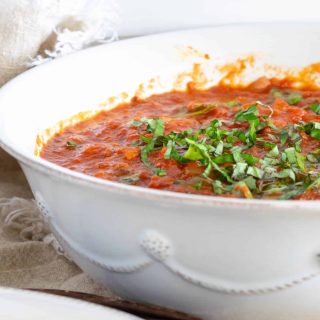
Spaghetti Arrabiata
Equipment
Ingredients
- 1 onion finely diced
- 8-10 garlic cloves minced
- 1-2 teaspoons of red pepper flakes
- 2 teaspoons crushed fennel seeds see note 1
- 1/4 cup good olive oil
- 2 28-ounces cans of whole, peeled San Marzano tomatoes
- Salt and Pepper
- 1/4 cup julienned fresh basil leaves plus more for garnishing (see note 2)
- 1/3 cup red wine such as Chianti optional
- Grated Parmesan Cheese for serving
Instructions
- Heat the olive oil over medium heat in a medium, heavy-bottomed pot or Dutch oven.
- Add the onions, crushed fennel seeds, and red pepper flakes and sautee for 5-7 minutes or until the onions are translucent.
- Add the garlic and saute for another 2 minutes.
- Add the two cans of tomatoes, including all liquid in the cans, 1 tablespoon of salt, and 1 teaspoon of black pepper, and use a large spoon or potato masher to mash or break the large tomatoes into smaller pieces. If you want to add red wine, add it now.
- Put the lid partially on the pot, leaving a space for steam to vent, and let gently simmer over medium-low to low heat for 1 hour. Stir every 10 minutes or so to prevent the sauce from sticking and/or burning.
- If you will be serving the Arrabiata Sauce immediately, cook the pasta by bringing a pot of salted water to a full boil. Add your spaghetti or other pasta and follow the package directions. (Reserve a little of the pasta water after your pasta has cooked in case you need to thin the Arrabiata sauce)
- Stir in the julienned basil leaves. Before serving, taste the sauce and adjust salt and pepper as needed.
- Serve over pasta.
- This Arrabiata Sauce freezes well. Let it come to room temperature before you freeze it in an airtight container.
Notes
- I use a spice grinder to grind my fennel coarsely. This handy tool also works for crushing whole cumin, cilantro, etc…
- Typically, a bunch of basil in the grocery store will yield approximately 1 cup of chopped basil.
Nutrition
Bookmark this page or pin the following image to refer back to this Spaghetti Arrabiata recipe in the future.
Thanks so much for spending a few minutes of your busy day with me!
To ensure you don’t miss future content, pop your email in the pale green box on the right or click here. I usually send one email weekly, so I won’t inundate your inbox. I’m sensitive to an overflowing email inbox!
We will only use your email address to send you emails, no more than 1-2 weekly. In addition, you will have access to my growing library of knit & crochet patterns and other printables. Check back often as this library will continue to grow. You can unsubscribe anytime by emailing me or clicking on the “unsubscribe” link at the bottom of all emails.
And you can access many of the products I refer to on my Nourish and Nestle Amazon Page. You can access it here.
So, if you’d like to participate in the ‘subscriber benefit’ action, simply subscribe to Nourish and Nestle here or use the form on the right sidebar. It’s slightly towards the top.
I have sent all my subscribers the link to the Subscriber Benefits Library. If you missed it or misplaced it, let me know.
Until next time…


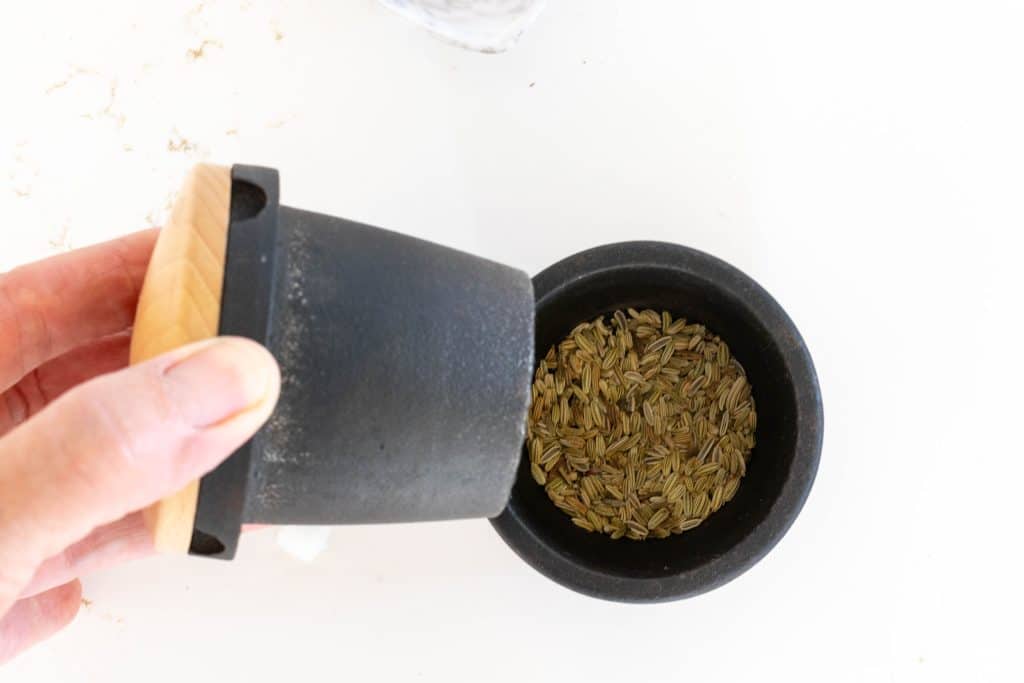
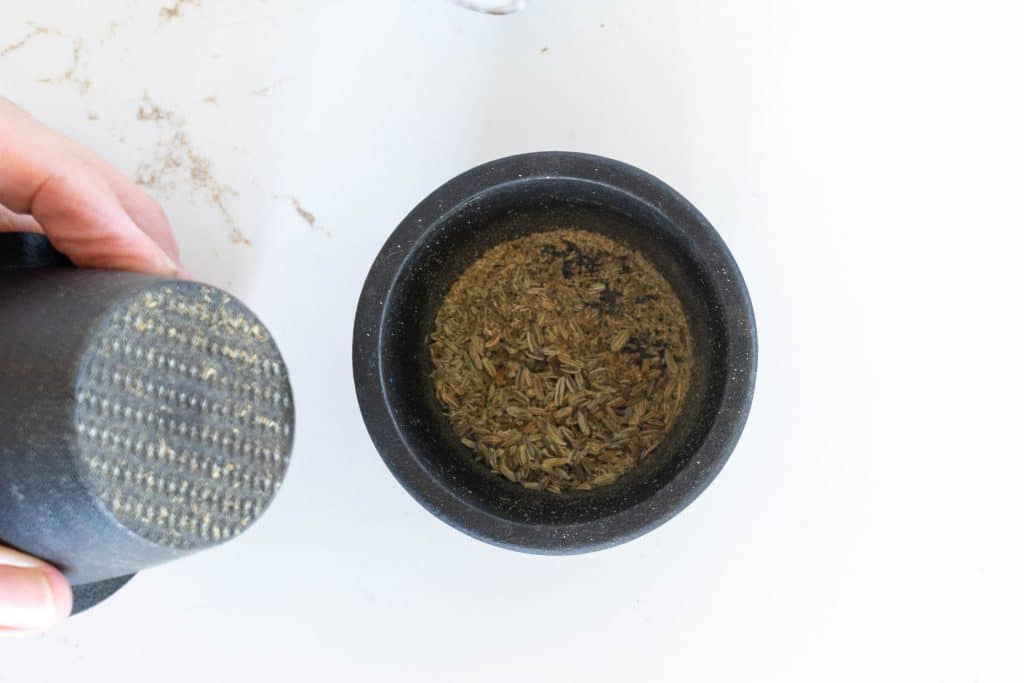
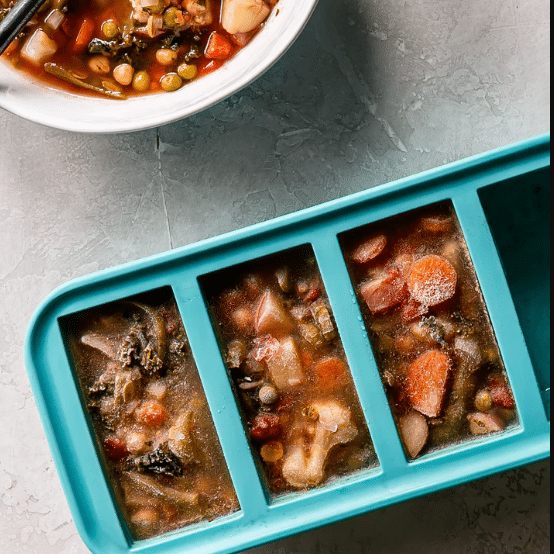
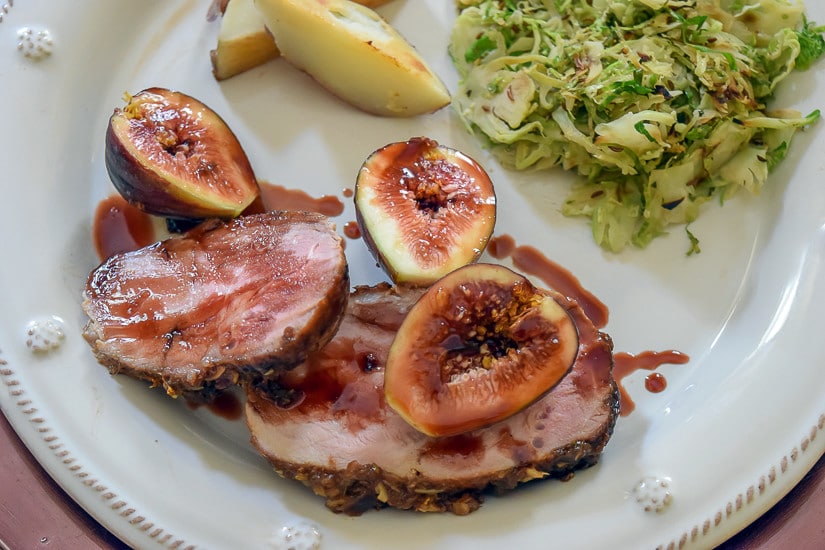
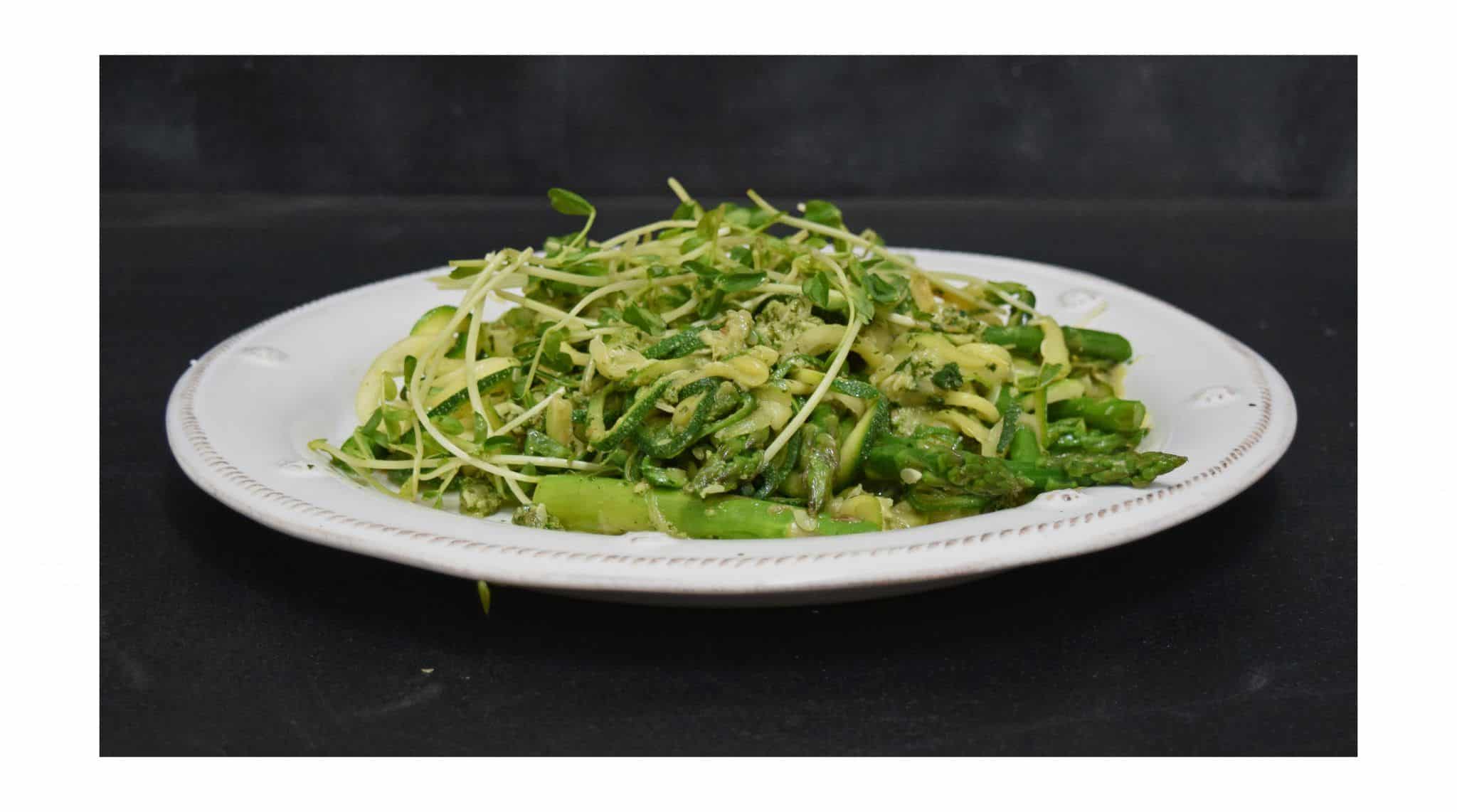

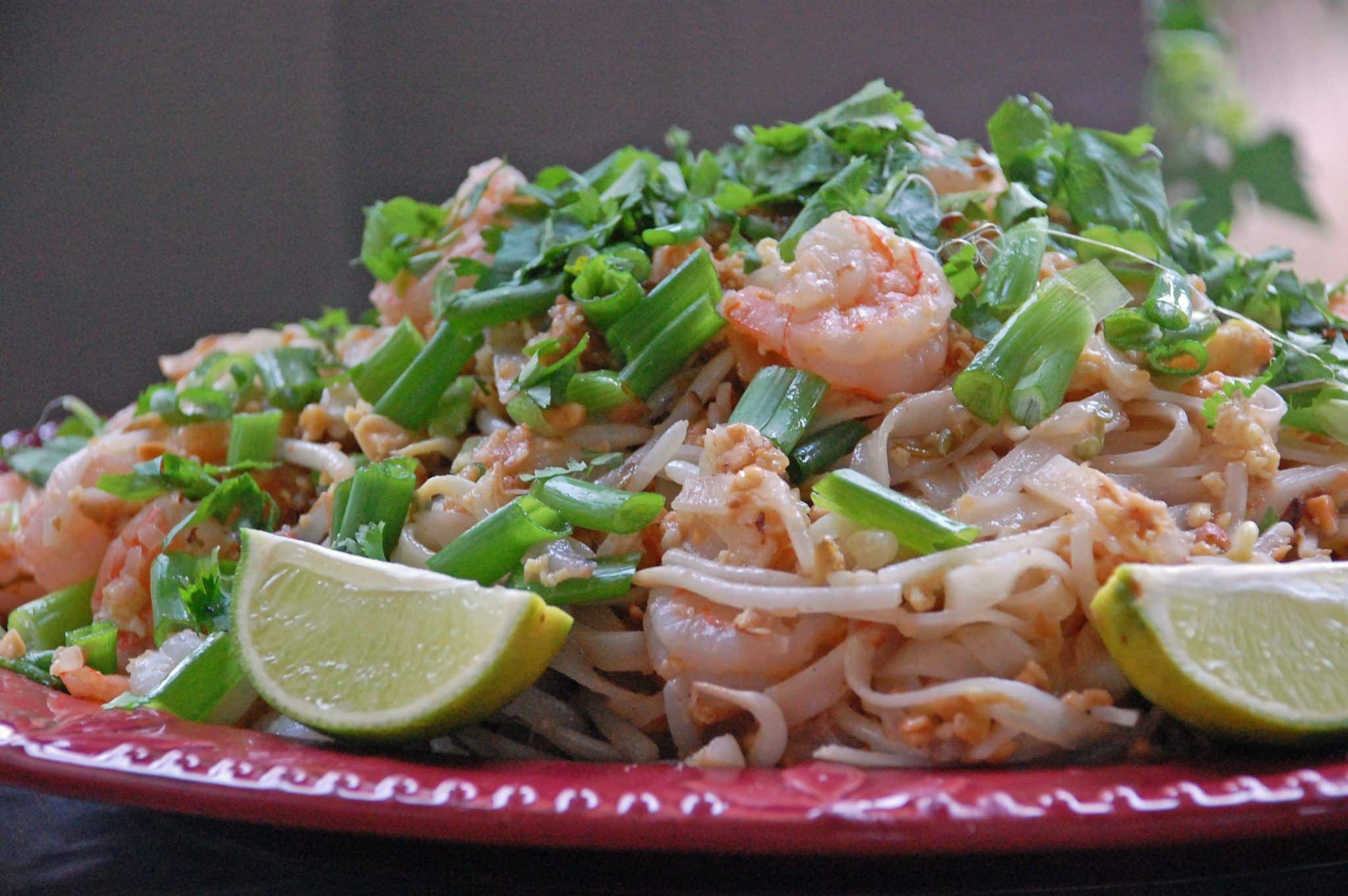
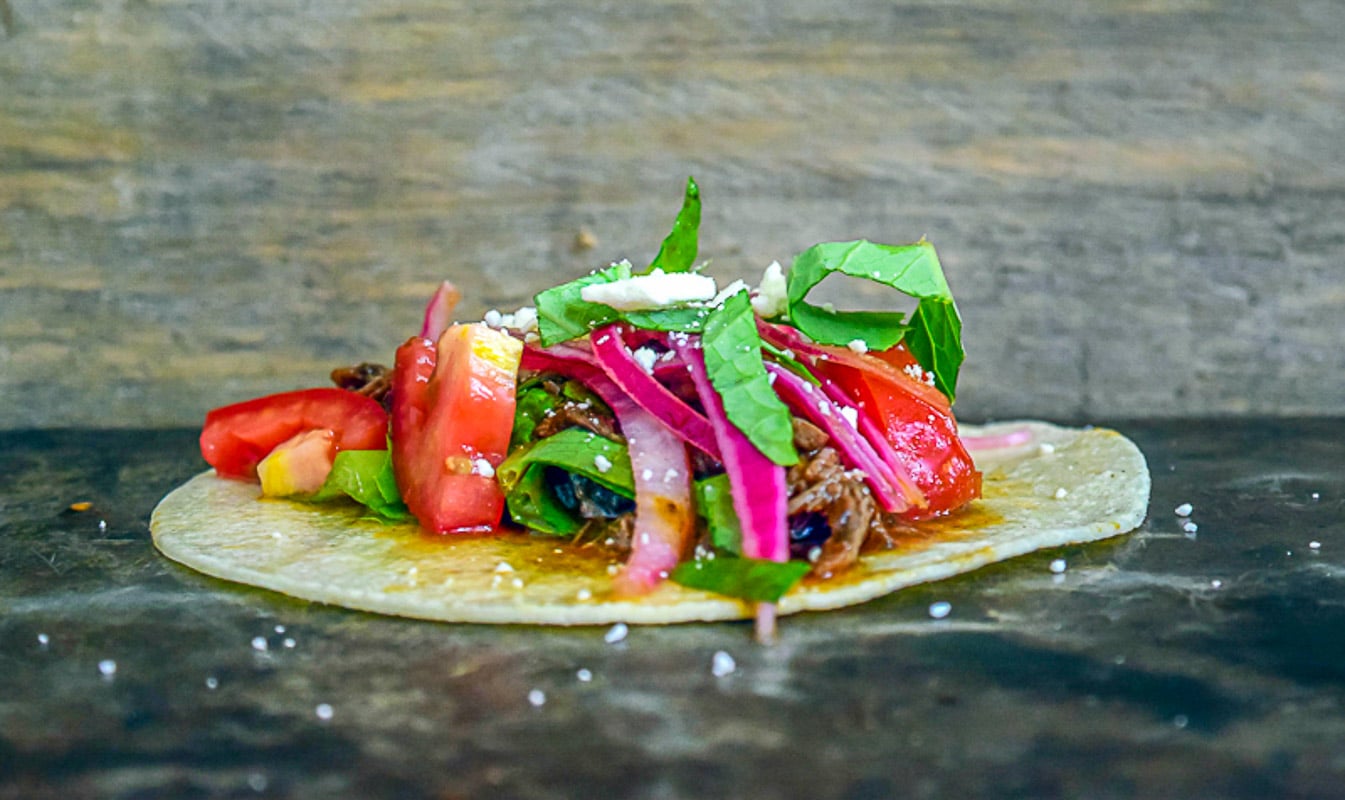
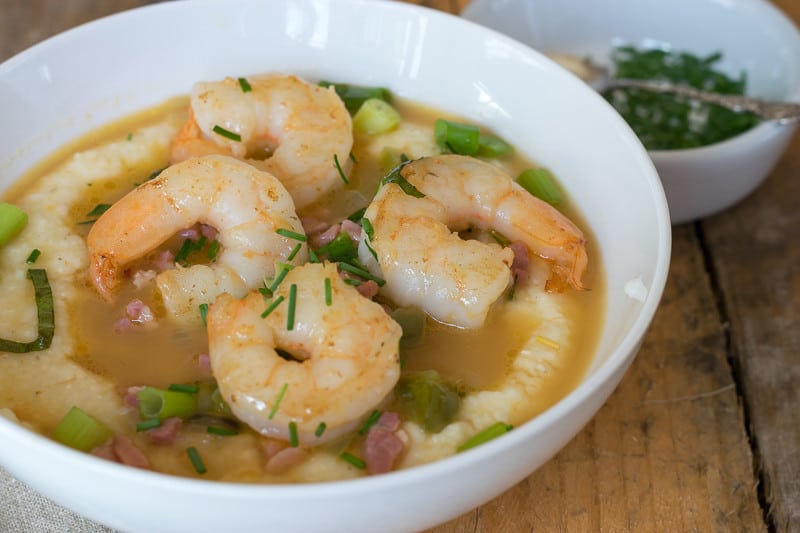
Hi .. definitely going to make this .. do you believe this amount of sauce is enough to mix into 1 lb of pasta ..
Randy
Hi Randy,
I do think it will be more than enough for a pound of pasta. On average, one pound of pasta typically requires 1 1/2 to 2 cups of sauce. Enjoy!
Oh yay! We had it the other night as well and Chianti was perfect with it!
What a great pairing!
This is my fave type of sauce! Nice and spicy! I have never tried it with fennel seeds and I have to say it’s another level of tasty!
Oh good! So glad you enjoyed it.